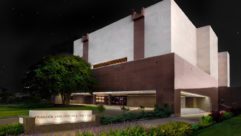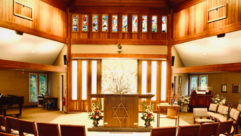
Wi-Fi World
Apr 10, 2014 11:33 AM,
By Tim Kridel
Supporting Stadium BYOD
Related Stories

For many AV integrators, stadiums and arenas are familiar territory. If that’s you, expect to see a lot more Wi-Fi on those job sites—both as an enabler for AV applications and a potential new professional services offering for your company.
The Sports and Entertainment Alliance in Technology (SEAT)Mobile Sports Report recently surveyed more than 50 managers at arenas and other sports facilities to see how they’re using technologies such as cellular and digital signage. One-third said they currently provide Wi-Fi for fans in all seating areas. Sound & Video Contractor checked with some franchises and venue owners and found there’s good reason to believe the other two-thirds will follow suit.
“Our CEO has publicly said that he thinks the most important thing facing sports franchises in the next several years is Wi-Fi and connectivity for the fans,” says Jack Elkins, business innovations manager for the Orlando Magic, which recently added Wi-Fi throughout Amway Center.
For the Magic and other teams, Wi-Fi’s business case often centers on delivering game-related content that enhances the fan experience.
“Fans want an immersive experience, whether they are viewing at the stadium or at home,” says Chuck Lukaszewski, Aruba Networks’ senior director of engineering. “The availability—or not—of this impacts where they will watch the game.”
In some cases, the wireless LAN (WLAN) also supports internal applications such as backhaul for AV gear and point-of-sale (POS) terminals.
“While we certainly are using Wi-Fi for fan connectivity and for developing the fan experience, we also run several systems within the stadium off of Wi-Fi, starting with ticket scanners and some POS,” says Chris Wyche, general manager of Sporting Park, home to Kansas City’s Major League Soccer team.
Experience Matters
Why the uptick in sports WLANs? One major reason is that the cost of Wi-Fi gear has plummeted over the past two years. Another reason is those products have become more sophisticated, such as being able to blanket a cavernous area or stadium. “When we opened our new building in 2010, the technology didn’t exist to make it financially feasible to put in Wi-Fi for the entire bowl,” Elkins says.
Then came products such as Cisco Connected Stadium Wi-Fi, which is a turnkey bundle of hardware, software, and professional services. Today, sports Wi-Fi is a booming market, which means plenty of companies are vying for business. But many of them are parachuting in with little or no experience with projects of this scale.
“We had great contractors when we upgraded,” Elkins says. “With a lot of contractors trying to break in, it can be tricky making sure you understand who can deliver and who can’t.”
Sports franchises and venue owners aren’t the only ones grappling with that challenge. So are AV integrators looking for partners to expand into sports Wi-Fi rather than taking on the cost, risk, and lead time of building their own team. And even when an integrator has no relationship with the company behind a facility’s WLAN, it still can run into challenges. One example is troubleshooting problems when signage and surveillance cameras have to piggyback on a poorly engineered WLAN.
Extensive experience is one thing that AV integrators, franchises, and facility owners all need to look for.
“It is important to research the potential partner to see if they are in other stadiums and have been successful,” says Lori Glasser-Seinera, American Airlines Center vice president of corporate sponsorship. An integrator should also set up a test demo for the stadium prior to commitment. There are lots of pieces to the puzzle when bringing in an integrator and making sure it works in conjunction with everything else in the venue.
Wi-Fi World
Apr 10, 2014 11:33 AM,
By Tim Kridel
Supporting Stadium BYOD

Big Buildings, Big Challenges
The scale of arenas and stadiums, typically at least a half-million square feet and 10,000-plus spectators, creates a number of variables that affect Wi-Fi reliability and performance. For example, there are at most only 24 channels available to serve an entire facility.
“Care must be taken in designing the layout of the Wi-Fi equipment such that channels can be reused repeatedly throughout the facility,” says Bruce Miller, Xirrus vice president of product marketing. “Physical isolation of access points from each other is key to this, ideally from walls, beams, or other barriers within the building structure.”
Interference also saps capacity. Those sources include microwave ovens in the concession areas, coaching staff headsets and, in the case of Amway Center, wireless Xbox game controllers that bled out in the bowl from a kids area in the upper concourse.
“It’s interesting where you find stuff,” Elkins says.
That stuff has a nasty habit of popping up unexpectedly, such as when fans have smartphones that double as Wi-Fi hotspots. One solution is to outfit the WLAN with spectrum analyzers, which continuously scan the Wi-Fi spectrum looking for interference sources and then devise ways to work around them. Sometimes AV gear can create interference, such as a surveillance camera that needs to be moved to another channel.
“It’s a constant effort requiring continuous surveillance and remediation,” Aruba’s Lukaszewski says. “Fortunately, some Wi-Fi management systems have integrated spectrum-reporting capabilities that can proactively inform the administrators of new interference sources so they don’t need to perform continuous manual checks.”
Another key issue is capacity. It’s common for franchises and venues to underestimate how much fans will use a WLAN, and that can lead to a poor experience for both them and any AV services on that network.

“Recently, we had the opportunity to participate in conversations around usage of team apps in venues and in particular, video services at a major event,” says Bill Anderson, a consultant at AmpThink, whose sports Wi-Fi projects include Amway Center. “We were surprised when we heard that the app vendor expected less than 3 percent of the fans to use the video service during the game. In a number of venues we support, we consistently see 20 percent or more of the fans connect to the network, and that number is growing.”
Arenas and stadiums often are used for concerts, tradeshows, and other non-game events that put a lot of people on the playing surface, where they’ll want or even need reliable Wi-Fi. For example, if some home show exhibitors are selling products, Wi-Fi might be the only way for them to process credit card transactions.
If exhibitors find that venue’s WLAN is unreliable, there’s a good chance they’ll resort to personal hotspots: handheld routers that use Wi-Fi to share a cellular broadband connection with multiple devices. Those hotspots can interfere with the WLAN and cause problems such as signage and cameras that suddenly lose their backhaul. So if a venue plans to host a lot of non-game events, it makes sense to ensure that the playing surface has seamless coverage.
“This is typically done with specially located access points at the field wall for an outdoor venue, or from overhead catwalks in indoor arenas,” Lukaszewski says. That’s one more example of why sports WLANs aren’t as straightforward as they might appear. But as more franchises and venue owners decide to add them, Wi-Fi becomes something that AV pros will increasingly have to work with or even enable.









